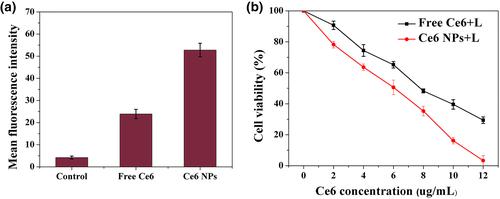一锅合成氯- e6纳米沉淀物用于大肠癌治疗
IF 3.8
4区 工程技术
Q1 BIOCHEMICAL RESEARCH METHODS
引用次数: 2
摘要
无附加载体的药物纳米颗粒在药物输送方面具有很大的前景,适用于癌症的治疗。在此,我们开发了一种一锅法制备氯e6 (Ce6)纳米沉淀物(Ce6 NPs),用于有效的光动力治疗结直肠癌。Ce6 NPs的载药量约为81%,具有良好的稳定性、较高的生物相容性和有效的活性氧(ROS)生成能力。因此,Ce6 NPs在激光照射下可以产生明显升高的ROS,比游离Ce6具有更好的抗癌效果。本文章由计算机程序翻译,如有差异,请以英文原文为准。

One-pot synthesis chlorin e6 nano-precipitation for colorectal cancer treatment Ce6 NPs for colorectal cancer treatment
The drug nanoparticles free of additional carriers hold great promise in drug delivery and are suitable for the therapy of cancers. Herein, we developed a one-pot method to prepare chlorin e6 (Ce6) nano-precipitations (Ce6 NPs) for effective photodynamic therapy of colorectal cancer. The drug loading of Ce6 NPs was around 81% and showed acceptable stability, high biocompatibility as well as effective reactive oxygen species (ROS) generation capability. As a result, the Ce6 NPs can produce significantly elevated ROS upon laser irradiations and achieved better anticancer benefits than free Ce6.
求助全文
通过发布文献求助,成功后即可免费获取论文全文。
去求助
来源期刊

IET nanobiotechnology
工程技术-纳米科技
CiteScore
6.20
自引率
4.30%
发文量
34
审稿时长
1 months
期刊介绍:
Electrical and electronic engineers have a long and illustrious history of contributing new theories and technologies to the biomedical sciences. This includes the cable theory for understanding the transmission of electrical signals in nerve axons and muscle fibres; dielectric techniques that advanced the understanding of cell membrane structures and membrane ion channels; electron and atomic force microscopy for investigating cells at the molecular level.
Other engineering disciplines, along with contributions from the biological, chemical, materials and physical sciences, continue to provide groundbreaking contributions to this subject at the molecular and submolecular level. Our subject now extends from single molecule measurements using scanning probe techniques, through to interactions between cells and microstructures, micro- and nano-fluidics, and aspects of lab-on-chip technologies. The primary aim of IET Nanobiotechnology is to provide a vital resource for academic and industrial researchers operating in this exciting cross-disciplinary activity. We can only achieve this by publishing cutting edge research papers and expert review articles from the international engineering and scientific community. To attract such contributions we will exercise a commitment to our authors by ensuring that their manuscripts receive rapid constructive peer opinions and feedback across interdisciplinary boundaries.
IET Nanobiotechnology covers all aspects of research and emerging technologies including, but not limited to:
Fundamental theories and concepts applied to biomedical-related devices and methods at the micro- and nano-scale (including methods that employ electrokinetic, electrohydrodynamic, and optical trapping techniques)
Micromachining and microfabrication tools and techniques applied to the top-down approach to nanobiotechnology
Nanomachining and nanofabrication tools and techniques directed towards biomedical and biotechnological applications (e.g. applications of atomic force microscopy, scanning probe microscopy and related tools)
Colloid chemistry applied to nanobiotechnology (e.g. cosmetics, suntan lotions, bio-active nanoparticles)
Biosynthesis (also known as green synthesis) of nanoparticles; to be considered for publication, research papers in this area must be directed principally towards biomedical research and especially if they encompass in vivo models or proofs of concept. We welcome papers that are application-orientated or offer new concepts of substantial biomedical importance
Techniques for probing cell physiology, cell adhesion sites and cell-cell communication
Molecular self-assembly, including concepts of supramolecular chemistry, molecular recognition, and DNA nanotechnology
Societal issues such as health and the environment
Special issues. Call for papers:
Smart Nanobiosensors for Next-generation Biomedical Applications - https://digital-library.theiet.org/files/IET_NBT_CFP_SNNBA.pdf
Selected extended papers from the International conference of the 19th Asian BioCeramic Symposium - https://digital-library.theiet.org/files/IET_NBT_CFP_ABS.pdf
 求助内容:
求助内容: 应助结果提醒方式:
应助结果提醒方式:


